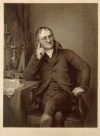An Overview of John Dalton’s Atomic Theory on the Atom
Matter is made up of tiny particles called Atoms.
Atoms of same elements are same while atoms of different elements are different however discovery of Isotopes and Isobars proved him Wrong.
Isotope: Atoms of same elements with different number of neutrons or mass number.
Example of Isotopes: Hydrogen has three isotopes, Protium( H-1), Deuterium(H-2) and Tritium( H-3).
Carbon has C-12, C-13 And C-14.
Atoms combine in ratios to form compounds.
Atoms can neither be created nor destroyed. Latest discoveries proved that new elements can be created by nuclear reactions.
Discover the remarkable contribution of John Dalton and his atomic theory to the scientific world! This overview explains the basics of Dalton’s atomic theory and its impact on science today.
The contributions of John Dalton, the English chemist and physicist, to modern science cannot be overstated. His atomic theory, first developed in 1803, remains one of the most important milestones in the history of science. Through his groundbreaking experiments and observations, Dalton laid down the foundation for how atoms behave and interact with each other – a foundation that still holds true today.
What is John Dalton’s Atomic Theory?
John Dalton’s atomic theory was an attempt to explain the various chemical reactions that take place in nature. According to his theory, all matter consists of atoms. These atoms have different sizes, shapes, and weights based on the element they are part of. He also proposed that atoms of a given element are identical in shape and mass and cannot be further divided into smaller particles.
How Did Dalton’s Theory Influence Modern Chemistry?
Dalton’s atomic theory helped to bridge a gap between physical and chemical changes. His work provided the foundation for chemical laws like the law of conservation of mass, which states that matter cannot be created or destroyed. Furthermore, Dalton’s atom model led to an understanding of how various elements interact with one another, making it easier for scientists to understand the makeup of substances on a molecular level.
What Features Did Dalton’s Atomic Theory Establish?
John Dalton’s atomic theory established several basic features of atoms, including the idea that they are small particles that make up all matter. He demonstrated that atoms of the same element have identical structure and properties, while atoms of different elements differ in size, mass, and other characteristics. He also indicated that atoms bond together to form molecules through chemical reactions. Additionally, Dalton’s theory proposed a law of multiple proportions which states that when two elements can combine to form two or more compounds, the respective masses of one element which combine with a fixed mass of the other element are always in a ratio of small whole numbers.
What Were the Limitations of Dalton’s Atomic Theory?
Dalton’s atomic theory had several limitations, including its failure to recognize the existence of subatomic particles. He also didn’t consider the idea that atoms could exist in different states, such as different arrangements of protons and neutrons or different energy levels. Additionally, Dalton didn’t understand that atoms can lose or gain electrons and be rearranged during chemical reactions. Finally, he proposed that all matter was made of atoms but failed to take into account the nuclear structure of some elements, which consists of protons, neutrons, and electrons.
How Has Dalton’s Atomic Theory Developed Over Time?
Dalton’s atomic theory has been developed and refined over time to reflect our current understanding of the atom. For example, we now know that atoms can interact in more complex ways than just combining in simple ratios during chemical reactions. We also understand that atoms come in different varieties, sometimes called “isotopes”, which have different numbers of protons, neutrons, and electrons. Additionally, scientists today are able to manipulate individual atoms by rearranging them into different molecules with varying properties. Thus, Dalton’s atomic theory served as a foundational stepping-stone for many of the advances made in physics and chemistry since then.
Share your thought on content of An Overview of John Dalton’s Atomic Theory on the Atom

